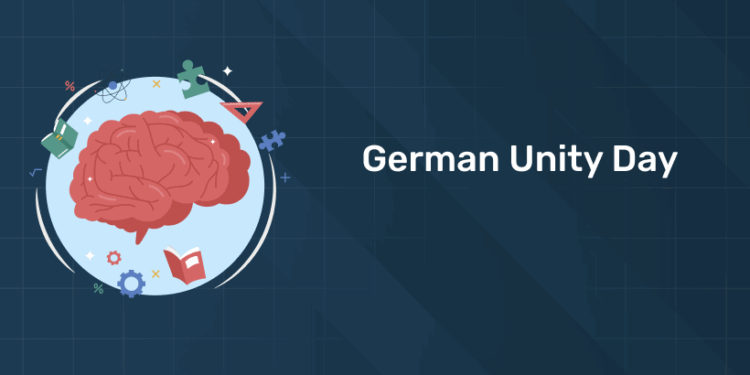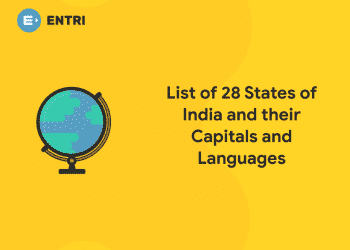Table of Contents
The German Unity Day is celebrated every year on 03rd October. This is Germany’s National Day and marks the reunification of Germany that took place on this day in 1990. when the Federal Republic of Germany (West Germany) and the German Democratic Republic (East Germany) were unified so that for the first time since 1945 there existed a single German state. The fall of the Berlin Wall on November 9, 1989, paved the way towards this national big day. People celebrate German Unity Day like a festival with great pomp and show.
German Unity Day 2025 Date – October 3
In this article readers can get a glimpse on
- History and Significance of German Unity Day
- German Unity Day Celebrations
- German Unity Day Quiz
German Unity Day 2025 History
1: Who was the first woman President of India?
Historically, Germany has associated various dates with its nationhood and unity, reflecting a complex and often turbulent path toward a unified state. However, to look back at the history of German Unity Day itself, the story officially began when the Federal Republic of Germany (FRG—West Germany) and the German Democratic Republic (GDR—East Germany) were unified in 1990, marking the creation of the first single German state since before World War II.
Paving the Way: The Fall of the Berlin Wall
The dramatic events of 1989 were the true catalysts. Mass protests against the communist regime in East Germany had been growing throughout the year. The entire process was accelerated by the unexpected and symbolic fall of the Berlin Wall on November 9, 1989. This moment, which effectively marked the end of the Cold War in Europe, unleashed an unstoppable popular demand for reunification.
The Road to October 3rd
Following the democratic election in East Germany in March 1990, the governments of the two German states began negotiations with the four former Allied powers (the United States, France, the United Kingdom, and the Soviet Union) in what was known as the “Two Plus Four Treaty.”
Meanwhile, the internal legal framework for unity was rapidly established. The Unification Treaty () was signed on September 20, 1990. This treaty declared that the GDR would officially dissolve and its five states would join the Federal Republic of Germany, with October 3 being designated as the date for this formal completion. This date was chosen because it allowed the unification to occur before the first all-German elections could be held in December 1990.
The Formal Sealing of Unity
The reunification was formally completed on October 3, 1990. The official decree sealed the end of the division of Germany, which had lasted for over four decades. The date was immediately declared the new national holiday, German Unity Day. Since then, it has been observed every year on this day in the country, celebrated not just as the anniversary of a legal event, but as a day of joyous national achievement and a testament to the power of a peaceful, democratic movement.
Free UPSKILLING Courses!
Take your first step toward mastering in-demand skills, acing interviews, and securing top-tier jobs with Entri's free upskilling courses.
Start Learning!How is German Unity Day Celebrated?
The German Unity Day is also known as Tag der Deutschen Einheit in German is celebrated on 3rd October that has been observing as the German National Holiday since 1990 after the formal completion of the reunification. On this very special and big day, German people celebrate in festivals that arrange a variety of stage programs, host several live bands and sell various food, drinks, and sweets around the Brandenburg Gate.
German Unity Day 2025 – Significance and Celebrations
German Unity Day () is much more than just a public holiday; it is a profound national commemoration of the German reunification that took place on October 3, 1990. The day celebrates the moment the Federal Republic of Germany (West Germany) and the German Democratic Republic (East Germany) united to form a single, federal German state, finally ending over four decades of painful national division.
Significance of the Day
The significance of German Unity Day lies in three key aspects:
- A Triumph of Peaceful Revolution: It celebrates a rare moment in history where a major political change was achieved not through violence or civil war, but through the courage and determination of peaceful protesters in East Germany, followed by diplomatic negotiations. This is often referred to as the Peaceful Revolution ().
- The End of the Cold War: The reunification effectively closed the final chapter of World War II’s aftermath and marked the definitive end of the Soviet bloc’s influence in Central Europe. It symbolized the victory of democracy and freedom over totalitarianism.
- Commitment to Democracy: By choosing October 3rd as the national holiday—instead of November 9th (the fall of the Berlin Wall, which is also associated with the dark history of Kristallnacht)—Germany emphasizes its commitment to the formal establishment of a unified democratic state based on the rule of law.
Celebrations Across Germany
As a national holiday, German Unity Day is celebrated with nationwide festivities, though the main official celebration rotates annually among the 16 German states.
- Official Ceremonies: The state holding the presidency of the Bundesrat (Federal Council) hosts the central, high-profile events. These typically include a solemn ecumenical service, an official ceremony with speeches from the President and Chancellor, and a Citizen’s Festival () to which the public is invited.
- Cultural Festivals and Public Events: Across the entire country, towns and cities host their own with street fairs, music concerts, food stalls, and historical exhibitions. These events aim to encourage togetherness and celebrate national identity.
- Symbolic Commemorations: In Berlin, the celebrations often focus on sites of historical significance, such as the Brandenburg Gate and the former crossing points of the Berlin Wall, serving as a powerful visual reminder of the division that was overcome.
In essence, German Unity Day is celebrated as a national event to not only remember the date of unification but to honor the spirit of the people who made it possible and to reaffirm the country’s unity and democratic values.
German Unity Day 2025 Facts
After being defeated in World War II, Germany was divided into four segments by the Allies, four powerful countries named the United States, Russia, France, and the United Kingdom. On May 23rd, 1949 the U.S, France, and the U.K segments became the Federal Republic of Germany and the Soviet Union segment became the German Democratic Republic on October 7th, 1949. Thus, Germany turned into two separate countries.
After the Monday Demonstrations, protests that were held by Citizens of the German Democratic Republic for the opening of the borders and proper political reform, East and West Germany become united in 1990. Below are some facts about German unity day.
- On May 23rd, 1949 the U.S, France, and the U.K segments became West Germany, and the Soviet Union segment became East Germany on October 7th, 1949.
- Monday Demonstration protests were held in 1989 by Citizens of the German Democratic Republic for the opening of the borders and proper political reform.
- On November 9th, 1989, checkpoints between East and West Germany were opened and people were allowed to move freely between them.
- The official demolition of the Berlin wall started on June 13th, 1990.
- Thus the fall of the Berlin Wall happened in 1989.
- On 3rd October 1990, the unification became official.
Free UPSKILLING Courses!
Take your first step toward mastering in-demand skills, acing interviews, and securing top-tier jobs with Entri's free upskilling courses.
Start Learning!German Unity Day Food 2025
German people love to celebrate historical and cultural events through different food and recipes. This special day brings the opportunity to German citizens to try some traditional and special German foods. Below are some special food items for German unity day 2025.
German unity day 2025 foods are Bratwurst, Rustic Wheat Rolls, Grilled Bratwurst and Sauerkraut Sandwich, Laugenbrezel, Butterkuchen, Black Forest Cake, Pfeffernüsse (Pepper Nuts), German Bierbrezeln, Kasekuchen, Fleischsalat, German Hot Lemon Drink, German Vanillekipferl, German Chocolate Cupcakes, etc.
German Reunification Quotes
Below are some quotes for you on the occasion of German unity day 2025.
- “Mister Gorbachev, tear down this wall!” – US President Ronald Reagan
- “Nobody has the intention of building a wall.” – GDR head of state Walter Ulbricht
- “Above all, don’t shoot at your fellow countrymen!” – West Berlin Mayor Willy Brandt
- “I take pride in the words Ich bin ein Berliner.” – US President John F. Kennedy
- “Now what belongs together will grow together.” – Willy Brandt
German Unity Day is a national huge day that symbolizes the reunification. The day helps the citizens of Germany to realize the power of unity. People wait the whole year for this day to celebrate the occasion every year in a grand way.
German Unity Day Quiz 2025
1. When is German Unity Day celebrated?
A) October 1
B) October 2
C) October 3
2. What event does German Unity Day commemorate?
A) The fall of the Berlin Wall
B) The reunification of East and West Germany
C) The end of World War II
3. In which year did German reunification take place?
A) 1989
B) 1990
C) 1991
4. Which city became the capital of unified Germany?
A) Bonn
B) Berlin
C) Munich
5. Which city served as the capital of West Germany before reunification?
A) Bonn
B) Hamburg
C) Frankfurt
6. What is the German name for German Unity Day?
A) Einheitstag
B) Tag der Deutschen Einheit
C) Deutscher Feiertag
7. Who was the Chancellor of West Germany during reunification?
A) Angela Merkel
B) Helmut Kohl
C) Gerhard Schröder
8. What year did the Berlin Wall fall, paving the way for reunification?
A) 1987
B) 1988
C) 1989
9. How many federal states (Bundesländer) does Germany have today?
A) 14
B) 15
C) 16
Want More Engaging Questions?
Download our FREE PDF packed with insightful quiz questions to test your knowledge!
🔽 Click below to get your free copy now! 🔽
German Unity Day Quiz 2025 PDF
German Unity Day is more than just a national holiday. It represents the triumph of democracy, freedom, and unity over division. The day reminds citizens of the struggles faced during the Cold War. It also celebrates the courage and determination of people on both sides of Germany. Through cultural events and public gatherings, Germans reflect on their shared history and achievements.
Today, German Unity Day inspires a sense of pride and togetherness. It highlights the importance of preserving peace and democracy for future generations. The celebrations across different cities show that unity is valued everywhere. This day strengthens national identity while honoring the lessons of the past. German Unity Day continues to symbolize hope, progress, and a united Germany.
Free UPSKILLING Courses!
Take your first step toward mastering in-demand skills, acing interviews, and securing top-tier jobs with Entri's free upskilling courses.
Start Learning!Frequently Asked Questions
What is German Unity Day?
German Unity Day is Germany’s national holiday celebrated on October 3. It marks the reunification of East and West Germany in 1990. The day symbolizes the end of division after decades of separation. It also represents the restoration of democracy and national unity. Today, it is celebrated as a reminder of freedom and togetherness.
Why is German Unity Day celebrated on October 3?
October 3 was chosen because it was the official date of reunification in 1990. On this day, East and West Germany became one nation again. The decision was made after the fall of the Berlin Wall in 1989. Leaders signed agreements to make reunification effective from this date. It is now a symbol of unity, peace, and democracy.
How do people in Germany celebrate German Unity Day?
Celebrations include cultural events, concerts, and public festivals. Each year, a different federal state hosts the official ceremony. Citizens attend parades, exhibitions, and political speeches. Fireworks and open-air performances are also common. Families often spend time together to mark the holiday.
What role did the Berlin Wall play in German Unity Day?
The Berlin Wall symbolized the division between East and West Germany. Built in 1961, it separated families and communities for decades. Its fall in November 1989 paved the way for reunification. Without the Wall coming down, unity would not have been possible. Therefore, German Unity Day is closely linked to this historic event.
Who was the Chancellor of West Germany during reunification?
Helmut Kohl was the Chancellor of West Germany in 1990. He played a major role in negotiating reunification. His policies helped bridge the political and social divide. Kohl is often called the “Chancellor of Unity” for this reason. His leadership remains a central part of the history of German Unity Day.
Why is German Unity Day important for Germans today?
It is a reminder of freedom after years of division. The holiday reflects the value of peace and democracy. It also honors the struggles faced during the Cold War. For many, it symbolizes hope and progress. Germans see it as a national day of pride and reflection.
What is the official name of German Unity Day in German?
The holiday is called “Tag der Deutschen Einheit.” The phrase directly translates to “Day of German Unity.” It emphasizes the togetherness of East and West Germany. This name highlights the importance of one unified nation. It is now recognized as Germany’s only official national holiday.
Which city hosts the main German Unity Day celebrations?
The celebrations rotate among Germany’s federal states. Each year, a different state hosts the main ceremony. This allows citizens across the country to take part. The program usually includes political speeches, concerts, and exhibitions. It shows that unity is celebrated equally in all regions.
How many federal states make up unified Germany today?
Germany has 16 federal states, known as Bundesländer. Five new states joined after reunification in 1990. These were from the former East Germany. Together, they form the modern Federal Republic of Germany. This structure represents both unity and diversity within the nation.
How does German Unity Day connect to global history?
German Unity Day is tied to the end of the Cold War. It represents the success of democracy over division. The reunification of Germany influenced European integration. It also changed international relations between East and West. The day is remembered as a global milestone for peace.











